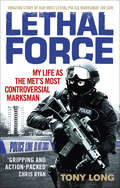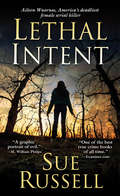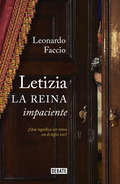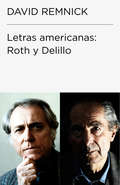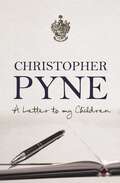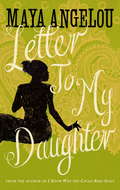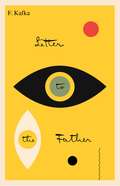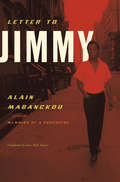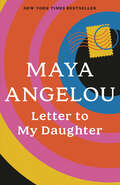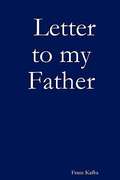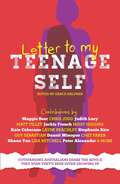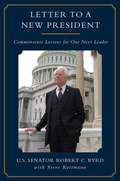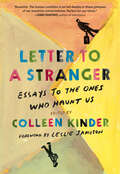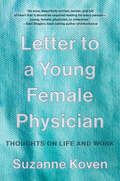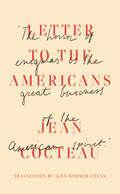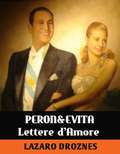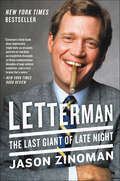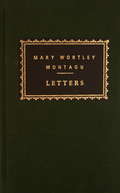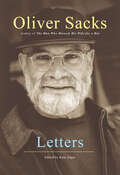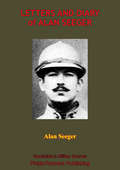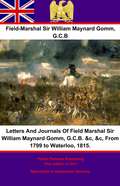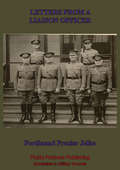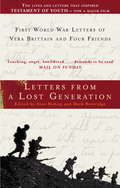- Table View
- List View
Lethal Force: My Life As the Met’s Most Controversial Marksman
by Tony LongTony Long was the best ‘shot’ the Met ever had. Under the codename ‘Echo 7’, he was ‘licenced to kill’ bringing down scores of targets, sometimes with deadly force. In 1985 he opened fire on a suspect to save a four-year-old girl whose mother had been stabbed to death by her assailant. Two years later he was involved in another high profile shooting while confronting three armed criminals. On both occasions Tony was commended by the Metropolitan Police Commissioner. But in the spring of 2005, coming face to face with suspected drug dealer and armed robber Azelle Rodney, a volley of point blank shots would bring his career crashing to an end, tarnish his reputation and leave him fighting a murder charge and possible life sentence. From life or death cases and botched operations to political fallouts, this book charts the controversial career from rookie seventies beat cop to Long's command of SO19 – the Met’s most elite specialist firearms unit. Long’s personal testimony and professional insight raises serious issues about the duties, pressures and responsibilities that fall on the shoulders of those we task to risk their lives, and take the lives of others, in our name.
Lethal Intent
by Sue RussellOn November 30, 1989, in a lonely place off Florida's Interstate 95, 51-year-old Richard Mallory shuddered under the impact of four .22-caliber slugs being pumped into him by a naked, hard-faced blonde hooker. While he suffered a slow, agonizing death, she stripped him of his valuables and drove his Cadillac back to the motel where her lesbian lover was waiting. In 1990, her killing spree kicked into high gear, with three men slain in as many weeks. Of the six of her seven male victims whose bodies were found, some were nude; all had been shot dead and robbed. In January, 1991, pawnshop records led to the arrest of Aileen Carol Wuornos, 34, aka "Lee," an abusive, alcoholic man hater with a murderous hairtrigger temper. Wuornos began prostituting herself at age 12 for cigarettes and beer. At 15 she bore an illegitimate child, at 16 she took to the highways as a hitchhiking hooker. In 1986, with a lengthy rap sheet and prison term under her belt, she entered into a relationship with Tyria Moore, 24. Tired of turning $20 tricks, Wuornos decided to rob her customers of everything they had -including their lives. Her arrest and trial prompted a worldwide media frenzy. Ultimately Wuornos received six separate death sentences. Here is the definitive account of a killer who confounded the profiling experts, forever changing their concepts of the crimes of which a woman is capable.
Letizia. La reina impaciente: ¿Qué significa ser reina en el siglo XXI?
by Leonardo Faccio¿Qué significa ser reina en el siglo XXI? Este perfil biográfico presenta por primera vez a Letizia Ortiz con todas sus fortalezas y contradicciones: su búsqueda incesante de la perfección, el descontento perpetuo con sí misma, sus ansias de controlarlo todo, pero también su ímpetu, audacia y rebeldía. La vida de la mujer que en menos de diez años pasó de un bloque de apartamentos en Oviedo a ser presentadora de televisión en Madrid y que acabó siendo princesa y reina de España. Tras cinco años y más de cien entrevistas, Leonardo Faccio radiografía la personalidad de la reina, una periodista que renuncia a su profesión pero no a sus batallas personales para ser parte de una monarquía en crisis que quiere modernizarse para sobrevivir.
Letras americanas: Roth y DeLillo
by David RemnickNacidos con apenas tres años de diferencia, Philip Roth (1933) y Don DeLillo (1936) son dos glorias vivas de las letras americanas que han sido retratados por la ágil pluma de David Remnick. Pocos escritores concitan tanta unanimidad como el estadounidense Philip Roth. Uno de los novelistas fundamentales de los últimos cincuenta años, fue el primer escritor vivo publicado en la Library of America. En este extraordinario perfil, Remnick repasa las obras maestras de Roth, la polémica que acompañó sus inicios tras la publicación de El lamento de Portnoy, la depresión que a mediados de los 90 le llevó a refugiarse en la literatura y las opiniones de Roth sobre el futuro de la literatura y las raíces de su arte.Si Roth es el escritor público, que se crece ante la hostilidad, Don DeLillo es el autor huidizo, que intenta evitar la exposición pública. Sin embargo, su obra, con cumbres como Submundo, o Libra le ha convertido en uno de los novelistas más prestigiosos de la actualidad. Remnick va en su busca a un pueblecito cercano a Nueva York y le acompaña en un paseo por su barrio natal para buscar los temas y las preocupaciones que marcan sus novelas.
Letter To My Children
by Christopher PyneWhy do seemingly intelligent men and women leave their families to spend more than half the year travelling to Canberra, and spending night after night at electorate and campaign events? Surely there are easier ways to earn a living. A Letter to My Children is Christopher Pyne's honest account of how a belief in the power of public service, inspired by his crusading ophthalmologist father, led him to pursue a career in politics, driven by the ambition of leaving a legacy for the next generation.
Letter To My Daughter
by Dr Maya AngelouA collection of wisdom and life lessons, from the beloved and bestselling author of I KNOW WHY THE CAGED BIRD SINGS 'A brilliant writer, a fierce friend and a truly phenomenal woman' BARACK OBAMADedicated to the daughter she never had but sees all around her, Letter to my Daughter reveals Maya Angelou's path to living well and living a life with meaning. Told in her own inimitable style, this book transcends genres and categories: it's part guidebook, part memoir, part poetry - and pure delight. 'She moved through the world with unshakeable calm, confidence and a fierce grace . . . She will always be the rainbow in my clouds' OPRAH WINFREY 'She was important in so many ways. She launched African American women writing in the United States. She was generous to a fault. She had nineteen talents - used ten. And was a real original. There is no duplicate' TONI MORRISON
Letter from Birmingham Jail
by Martin Luther King Jr.During the struggle for civil rights in the 1960s, Martin Luther King emerged as the movement's most eloquent leader. The two selections here testify to the emotional and logical power of his arguments. In "Letter from Birmingham Jail," King explains why blacks can no longer be prisoners of inequality. His "I Have a Dream" speech, delivered to 250,000 civil rights marchers in 1963, is another moving appeal for equality.
Letter to His Father: Bilingual Edition (The Schocken Kafka Library)
by Franz KafkaFranz Kafka wrote this letter to Hermann Kafka in November 1919; he was then thirty-six years old. Max Brod relates that Kafka actually gave it to his mother to hand to his father, hoping that it might renew a relationship that had disintegrated into tension and frustration on both sides. Kafka's probing of the abyss between them spared neither his father nor himself, and his cry for acceptance has an undertone of despair. He could not help seeing the lack of understanding between father and son as another moment in the universal predicament depicited in so much of his work. Probably realizing the futility of her son's gesture, his mother did not deliver the letter, but returned it to Kafka instead. Kafka died five years later, in 1924, of tuberculosis.
Letter to Jimmy
by Alain MabanckouWritten on the twentieth anniversary of James Baldwin's death, Letter to Jimmy is African writer Alain Mabanckou's ode to his literary hero and an effort to place Baldwin's life in context within the greater African diaspora.Beginning with a chance encounter with a beggar wandering along a Santa Monica beach-a man whose ragged clothes and unsteady gait remind the author of a character out of one of James Baldwin's novels- Mabanckou uses his own experiences as an African living in the US as a launching pad to take readers on a fascinating tour of James Baldwin's life. As Mabanckou reads Baldwin's work, looks at pictures of him through the years, and explores Baldwin's checkered publishing history, he is always probing for answers about what it must have been like for the young Baldwin to live abroad as an African-American, to write obliquely about his own homosexuality, and to seek out mentors like Richard Wright and Ralph Ellison only to publicly reject themlater.As Mabanckou travels to Paris, reads about French history and engages with contemporary readers, his letters to Baldwin grow more intimate and personal. He speaks to Baldwin as a peer-a writer who paved the way for his own work, and Mabanckou seems to believe, someone who might understand his experiences as an African expatriate.
Letter to My Daughter
by Maya AngelouNEW YORK TIMES BESTSELLER • Maya Angelou shares her path to living well and with meaning in this absorbing book of personal essays. Dedicated to the daughter she never had but sees all around her, Letter to My Daughter transcends genres and categories: guidebook, memoir, poetry, and pure delight. Here in short spellbinding essays are glimpses of the tumultuous life that led Angelou to an exalted place in American letters and taught her lessons in compassion and fortitude: how she was brought up by her indomitable grandmother in segregated Arkansas, taken in at thirteen by her more worldly and less religious mother, and grew to be an awkward, six-foot-tall teenager whose first experience of loveless sex paradoxically left her with her greatest gift, a son. Whether she is recalling such lost friends as Coretta Scott King and Ossie Davis, extolling honesty, decrying vulgarity, explaining why becoming a Christian is a &“lifelong endeavor,&” or simply singing the praises of a meal of red rice–Maya Angelou writes from the heart to millions of women she considers her extended family. Like the rest of her remarkable work, Letter to My Daughter entertains and teaches; it is a book to cherish, savor, re-read, and share. &“I gave birth to one child, a son, but I have thousands of daughters. You are Black and White, Jewish and Muslim, Asian, Spanish speaking, Native Americans and Aleut. You are fat and thin and pretty and plain, gay and straight, educated and unlettered, and I am speaking to you all. Here is my offering to you.&”—from Letter to My Daughter
Letter to My Father
by Franz Kafka Howard ColyerThis letter is the closest that Kafka came to setting down his autobiography. He was driven to write it by his father's opposition to his engagement with Julie Wohryzek. The marriage did not take place; the letter was not delivered.
Letter to My Teenage Self
by Grace HalphenMelbourne teenager Grace Halphen had a tough time transitioning to high school - she struggled to make friends and fit in. When she realised that this is a common experience, she wondered why she'd felt so alone. At thirteen, Grace embarked on a project to contact all the Australian public figures she admires, asking them to provide advice to help teenagers navigate the inevitable ups and downs of adolescence.In Letter to My Teenage Self, more than 50 prominent Australians write heartfelt letters to their younger selves, passing on the wisdom they wish they'd had at the time. From learning to laugh at yourself (Adam Gilchrist), realising that the qualities that make you stand out are the ones that make you so rad (Missy Higgins), not letting the negatives shape who you become (Guy Sebastian), practising gratitude (Nathan Buckley), and the reassurance that you'll get over anger about people treating you badly because you'll get better at treating yourself well (Judith Lucy), Letter to My Teenage Self provides inspiration for parents and teenagers alike.Contributors include: Maggie Beer, Chris Judd, Judith Lucy, Matt Tilley, Adam Gilchrist, Jen Cloher, Jackie French, Missy Higgins, Nathan Buckley, Kate Ceberano, Josh Frydenberg, Layne Beachley, Stephanie Rice, David Koch, Guy Sebastian, Alice Pung, Dannii Minogue, Chet Faker, Shaun Tan, Richard Joseph Frankland, Lisa Mitchell, Jo Stanley, Peter Alexander.All profits from the sale of this book go to the REACH FOUNDATION, helping all teenagers reach their full potential.
Letter to a New President: Commonsense Lessons for Our Next Leader
by Robert C. Byrd Steve Kettmann[From Jacket] "In 'Letter to a New President,' Byrd recounts lessons drawn from his remarkable life as a young boy growing up poor in the coalfields of southern West Virginia to his meteoric rise to the pinnacles of power in Washington, D.C. Byrd focuses his observations on underappreciated and seldom discussed virtues like personal responsibility, careful consideration before making decisions, and a sense of decency and fairness even toward fierce opponents. A student of history and a defender of our Constitution, Byrd looks to the past for lessons and, in 'Letter to a New President,' studies present failures as guides for constructive lessons for the future."
Letter to a Stranger: Essays to the Ones Who Haunt Us
by Colleen Kinder&“Beautiful. The human condition is on full display in these glimpses of our essential connectedness. Perfect for our times.&” —Dani Shapiro, author of Inheritance Sixty-five extraordinary writers grapple with this mystery: How can an ephemeral encounter with a stranger leave such an eternal mark? When Colleen Kinder put out a call for authors to write a letter to a stranger about an unforgettable encounter, she opened the floodgates. The responses—intimate and addictive, all written in the second person—began pouring in. These short, insightful essays by a remarkable cast of writers, including Elizabeth Kolbert, Pico Iyer, Lauren Groff, Gregory Pardlo, Faith Adiele, Maggie Shipstead, Lia Purpura, Kiki Petrosino, and Jamil Jan Kochai, are organized around such themes as Gratitude, Wonder, and Farewell and guide us both across the globe and through the mysteries of human connection. Addressed to a first responder after a storm, a gambler encountered on jury duty, a waiter in Istanbul, a taxi driver in Paris, a roomful of travelers watching reality TV in La Paz, and dozens of others, the pieces are replete with observations about how to live and what we seek, and how a stranger&’s loaded glance, shared smile, or question posed can alter the course of our lives. Moving and unforgettable, Letter to a Stranger is an irresistible read for the literary traveler and the perfect gift for anyone who is haunted by a person they met once and will remember forever.
Letter to a Young Female Physician: Notes From A Medical Life
by Suzanne KovenA poignant and funny exploration of authenticity in work and life by a woman doctor. In 2017, Dr. Suzanne Koven published an essay describing the challenges faced by female physicians, including her own personal struggle with "imposter syndrome"—a long-held secret belief that she was not smart enough or good enough to be a “real” doctor. Accessed by thousands of readers around the world, Koven’s “Letter to a Young Female Physician” has evolved into a deeply felt reflection on her career in medicine. Koven tells candid and illuminating stories about her pregnancy during a grueling residency in the AIDS era; the illnesses of her child and aging parents during which her roles as a doctor, mother, and daughter converged, and sometimes collided; the sexism, pay inequity, and harassment that women in medicine encounter; and the twilight of her career during the COVID-19 pandemic. As she traces the arc of her life, Koven finds inspiration in literature and faces the near-universal challenges of burnout, body image, and balancing work with marriage and parenthood. Shining with warmth, clarity, and wisdom, Letter to a Young Female Physician reveals a woman forging her authentic identity in a modern landscape that is as overwhelming and confusing as it is exhilarating in its possibilities. Koven offers an indelible account, by turns humorous and profound, from a doctor, mother, wife, daughter, teacher, and writer who sheds light on our desire to find meaning, and on a way to be our own imperfect selves in the world.
Letter to the Americans
by Jean CocteauLike Alexis de Tocqueville a century earlier, Jean Cocteau offers a powerful reminder to Americans of their own potential—and issues In 1949, Jean Cocteau spent twenty days in New York, and began composing on the plane ride home this essay filled with the vivid impressions of his trip. With his unmistakable prose and graceful wit, he compares and contrasts French and American culture: the different values they place on art, literature, liberty, psychology, and dreams. Cocteau sees the incredibly buoyant hopes in America’s promise, while at the same time warning of the many ills that the nation will have to confront—its hypocrisy, sexism, racism, and hegemonic aspirations—in order to realize this potential. Never before translated into English, Letter to the Americans remains as timely and urgent as when it was first published in France over seventy years ago.
Lettere D'amore Di Evita & Peron
by Lazaro DroznesPeron & Evita. Lettere d'amore: di Lázaro Droznes La straordinaria storia di Maria Eva Duarte de Peron nei suoi 33 anni di vita intensa è diventata un mito universale. Peron ed evitare. lettere d'amore: La traiettoria della vita di Maria Eva Duarte de Peron è una delle storie più straordinarie mai raccontate. Questo lavoro, sulla base di uno scambio epistolare apocrifa, getta uno sguardo alla esperienza soggettiva dei protagonisti di una delle storia d'amore più intenso che è stato l'Argentina. La morte di Evita è probabilmente dovuta al suo rifiuto di accettare qualsiasi trattamento medico. La sua frase "I dottori sono per i disoccupati, non per me. I trattamenti sono per gli oligarchi, per i quali non trabajan.¿No ti rendi conto che voglio inventare malattie di sabotare la mia gestione? "Esemplifica ciò che i greci chiamavano" hybris "-la malattia power-, che è l'ingrediente essenziale tutta la tragedia. In un periodo vitale di 33 anni, Evita è diventata un mito di portata universale. Questa drammatica fiction include le seguenti fasi della vita fantastica di Evita: parto naturale come la seconda famiglia di un proprietario terriero della provincia di Buenos Aires. Viaggio a 15 anni a Buenos Aires e solitudine nella grande città Sopravvivenza come cortigiana e attrice teatrale e radiofonica. Nascita e consegna di una figlia Matrimonio con il colonnello Perón. Moglie del Presidente e First Lady of the Nation. Viaggio in Europa. Trasformazione di Eva in Evita nel suo lavoro della Fondazione. Malattia, operazioni, menzogne e morte. Imbalsamazione del corpo di Evita. Scomparsa e ritorno del corpo imbalsamato. Reclami "post mortem" per le decisioni del vedovo nel suo terzo presidenza.
Letterman: The Last Giant of Late Night
by Jason ZinomanNew York Times comedy critic Jason Zinoman delivers the definitive story of the life and artistic legacy of David Letterman, the greatest television talk show host of all time and the signature comedic voice of a generation.In a career spanning more than thirty years, David Letterman redefined the modern talk show with an ironic comic style that transcended traditional television. While he remains one of the most famous stars in America, he is a remote, even reclusive, figure whose career is widely misunderstood. In Letterman, Jason Zinoman, the first comedy critic in the history of the New York Times, mixes groundbreaking reporting with unprecedented access and probing critical analysis to explain the unique entertainer’s titanic legacy. Moving from his early days in Indiana to his retirement, Zinoman goes behind the scenes of Letterman’s television career to illuminate the origins of his revolutionary comedy, its overlooked influences, and how his work intersects with and reveals his famously eccentric personality. Zinoman argues that Letterman had three great artistic periods, each distinct and part of his evolution. As he examines key broadcasting moments—"Stupid Pet Tricks" and other captivating segments that defined Late Night with David Letterman—he illuminates Letterman’s relationship to his writers, and in particular, the show’s co-creator, Merrill Markoe, with whom Letterman shared a long professional and personal connection.To understand popular culture today, it’s necessary to understand David Letterman. With this revealing biography, Zinoman offers a perceptive analysis of the man and the artist whose ironic voice and caustic meta-humor was critical to an entire generation of comedians and viewers—and whose singular style ushered in new tropes that have become clichés in comedy today.
Letters
by Mary Wortley MontaguImmensely learned, self-educated in an era when formal schooling was denied to women, Mary Wortley Montagu was an admired poet, a consistently scandalous doyenne of eighteenth-century London society, and, in a period when letter-writing had been elevated to an art form, one of the greatest letter writers in the English language. Her epistles, meant for both public and private consumption, are the product of a mind distinguished by its adventurousness, its indifference to convention, and its eagerness not only to acquire knowledge but to convey it with unmitigated style and grace.(Book Jacket Status: Not Jacketed)
Letters
by Oliver SacksThe letters of one of the greatest observers of the human species, revealing his passion for life and work, friendship and art, medicine and society, and the richness of his relationships with friends, family, and fellow intellectuals over the decades, collected here for the first time&“Here is the unedited Oliver Sacks—struggling, passionate, a furiously intelligent misfit. And also endless interesting. He was a man like no other.&” —Atul Gawande, author of Being MortalDr. Oliver Sacks—who describes himself in these pages as a &“philosophical physician&” and a &“neuropathological Talmudist&”—wrote letters throughout his life: to his parents and his beloved Auntie Len, to friends and colleagues from London, Oxford, California, and around the world. The letters begin with his arrival in America as a young man, eager to establish himself away from the confines of postwar England, and carry us through his bumpy early career in medicine and the discovery of his writer&’s voice; his weight-lifting, motorcycle-riding years and his explosive seasons of discovery with the patients who populate his book Awakenings; his growing interest in matters of sight and the musical brain; his many friendships and exchanges with writers, artists, and scientists (to say nothing of astronauts, botanists, and mathematicians), and his deep gratitude for all these relationships at the end of his life.Sensitively introduced and edited by Kate Edgar, Sacks&’s longtime editor, the letters deliver a portrait of Sacks as he wrestles with the workings of the brain and mind. We see, through his eyes, the beginnings of modern neuroscience, following the thought processes of one of the great intellectuals of our time, whose words, as evidenced in these pages, were unfailingly shaped with generosity and wonder toward other people.
Letters
by Oliver SacksThe letters of one of the greatest observers of the human species, revealing his passion for life and work, friendship and art, medicine and society, and the richness of his relationships with friends, family, and fellow intellectuals over the decades, collected here for the first time &“Here is the unedited Oliver Sacks—struggling, passionate, a furiously intelligent misfit. And also endless interesting. He was a man like no other.&” —Atul Gawande, author of Being MortalDr. Oliver Sacks—who describes himself in these pages as a &“philosophical physician&” and a &“neuropathological Talmudist&”—wrote letters throughout his life: to his parents and his beloved Auntie Len, to friends and colleagues from London, Oxford, California, and around the world. The letters begin with his arrival in America as a young man, eager to establish himself away from the confines of postwar England, and carry us through his bumpy early career in medicine and the discovery of his writer&’s voice; his weight-lifting, motorcycle-riding years and his explosive seasons of discovery with the patients who populate his book Awakenings; his growing interest in matters of sight and the musical brain; his many friendships and exchanges with writers, artists, and scientists (to say nothing of astronauts, botanists, and mathematicians), and his deep gratitude for all these relationships at the end of his life.Sensitively introduced and edited by Kate Edgar, Sacks&’s longtime editor, the letters deliver a portrait of Sacks as he wrestles with the workings of the brain and mind. We see, through his eyes, the beginnings of modern neuroscience, following the thought processes of one of the great intellectuals of our time, whose words, as evidenced in these pages, were unfailingly shaped with generosity and wonder toward other people.
Letters And Diary Of Alan Seeger
by Alan Seeger"I HAVE a rendezvous with DeathAt some disputed barricade,When Spring comes back with rustling shadeAnd apple-blossoms fill the airI have a rendezvous with DeathWhen Spring brings back blue days and fair"The above unfortunately prophetic lines were written by the famed war poet Alan Seeger months before his death at the hands of German fire during the infamous slaughter of the battle of the Somme whilst serving in the French Foreign Legion. He saw a great deal of fighting in his two years with the French, indeed some of the worst of it as the Legion was posted many times to the most exposed parts of the lines. His diary entries are a strange mixture of his service under heavy fire with his common fellow poilus, which he faced so stoically despite having a heavy premonition of his own death, and his poetic insights into daily life.Well-known and well-liked by his colleagues they set about collecting his notes and poems into this memorial volume to commemorate his achievements in the French army and his literary attainments.
Letters And Journals Of Field Marshal Sir William Maynard Gomm, G.C.B. &c, &c, From 1799 to Waterloo, 1815.
by Field-Marshal Sir William Maynard Gomm G.C.BThis ebook is purpose built and is proof-read and re-type set from the original to provide an outstanding experience of reflowing text for an ebook reader. Field-Marshal Gomm's letters and journals provide a first-rate account of the numerous actions, battles and events that he was involved in during the Napoleonic wars. A seasoned officer from a military family, he was an acute observer of all that went on around him, and the notes and letters he wrote, edited by his son, provide a capital trove of information. This collection of his diary entries and letters focuses on the Napoleonic Wars, although he would rise to the highest rank in the British Army and C-in-C of India. Engaged in the early campaigns of the British Army against the French forces from 1799, he was one of the few officers that fought in the Peninsular War and the Waterloo campaign that actually had some staff training, having passed through Staff College. Many of his contemporaries were somewhat amateur in their outlook to soldiering, but Gomm was a thoughtful and assiduously thorough officer. After the campaign in Portugal and Spain, first under Wellington and then under Sir John Moore, he managed to survive the Walcheren expedition and was then posted back to Spain, where he would serve out the Peninsular war. Present at the battles of Busaco, Fuentes d'Oñoro, Salamanca, Vittoria, the Pyrenees, the Nive, the Nivelle and St Pierre, as well as the sieges of Cuidad Rodrigo and Badajoz, he was a lieutenant-colonel by the time he left for England. This was a fairly rapid ascent for the time, a signal confirmation of his abilities as a staff and regimental officer, and some influence at home, no doubt. Appointed to the post of Quartermaster General of Picton's fifth division, he was to see the furious combat of Quatre Bras and the "hard pounding" of Waterloo two days later. His position as an unattached staff officer gave him a view of the fields of battle from a position on horseback, and with freedom of movement around the field that few could match. His contemporaneous notes and letters of Waterloo are annotated with his more considered thoughts and views, particularly regarding the "crisis" of Waterloo, the repulse of the last columns of the Garde Impèriale. Text taken, whole and complete from the 1881 edition, John Murray, London. Original -438 pages Author - Field-Marshal Sir William Maynard Gomm, G.C.B (1784-1875) Editor - Francis Culling Carr-Gomm (1834-1919) Introduction - Francis Culling Carr-Gomm (1834-1919) Illustrations - 1 Portrait Linked TOC.
Letters From A Liasion Officer
by Captain Ferdinand Frazier JelkeIt goes without saying that the letters here gathered were not written with any idea of being permanently preserved. They were merely a progressive recital, in a most informal and unstudied vein, of circumstances and scenes with which the writer came in touch in the course of his work, first in the ranks of the Marine Corps, and afterward as a Lieutenant of Infantry in the Liaison Service, in France.But since the author's return from "Over There"--and in view of the gigantic scale of World War and the epochal character of the events and situations touched upon in the correspondence--members of his family have urged that the series of letters written from the scenes of his activities during 1917-'19, be made into a handy volume for the use of such friends as may find in them some personal appeal and interest.In preparing the letters for publication an attempt has been made to omit the more private and intimate details, while retaining such of the descriptive text as would aid the reader in gaining some lasting impressions of the scenes and incidents which rushed by, like an animated panorama, in those days of frenzied endeavour and kaleidoscopic change, beginning shortly after America's entrance into the war and continuing until after the signing of the Armistice, and the return of the writer to America, early in 1919.
Letters From A Lost Generation: First World War Letters of Vera Brittain and Four Friends
by Mark BostridgeNothing in the papers, not the most vivid and heart-rending descriptions, have made me realise war like your letters' Vera Brittain to Roland Leighton, 17 April 1915.This selection of letters, written between 1913 & 1918, between Vera Brittain and four young men - her fiance Roland Leighton, her brother Edward and their close friends Victor Richardson & Geoffrey Thurlow present a remarkable and profoundly moving portrait of five young people caught up in the cataclysm of total war. Roland, 'Monseigneur', is the 'leader' & his letters most clearly trace the path leading from idealism to disillusionment. Edward, ' Immaculate of the Trenches', was orderly & controlled, down even to his attire. Geoffrey, the 'non-militarist at heart' had not rushed to enlist but put aside his objections to the war for patriotism's sake. Victor on the other hand, possessed a very sweet character and was known as 'Father Confessor'. An important historical testimony telling a powerful story of idealism, disillusionment and personal tragedy.
